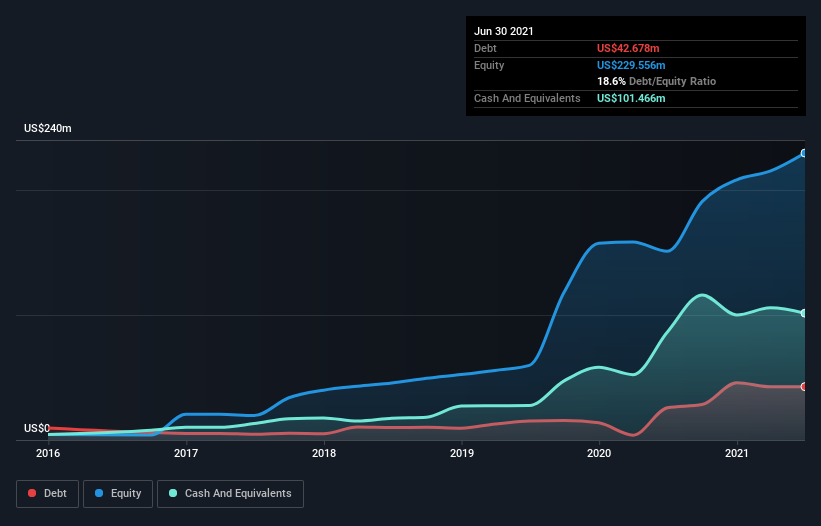Does ACM Research (NASDAQ:ACMR) Have A Healthy Balance Sheet?
Some say volatility, rather than debt, is the best way to think about risk as an investor, but Warren Buffett famously said that 'Volatility is far from synonymous with risk.' So it might be obvious that you need to consider debt, when you think about how risky any given stock is, because too much debt can sink a company. We can see that ACM Research, Inc. (NASDAQ:ACMR) does use debt in its business. But the real question is whether this debt is making the company risky.
When Is Debt Dangerous?
Debt is a tool to help businesses grow, but if a business is incapable of paying off its lenders, then it exists at their mercy. Part and parcel of capitalism is the process of 'creative destruction' where failed businesses are mercilessly liquidated by their bankers. However, a more common (but still painful) scenario is that it has to raise new equity capital at a low price, thus permanently diluting shareholders. Of course, debt can be an important tool in businesses, particularly capital heavy businesses. When we think about a company's use of debt, we first look at cash and debt together.
See our latest analysis for ACM Research
How Much Debt Does ACM Research Carry?
As you can see below, at the end of June 2021, ACM Research had US$42.7m of debt, up from US$25.8m a year ago. Click the image for more detail. However, it does have US$101.5m in cash offsetting this, leading to net cash of US$58.8m.
How Healthy Is ACM Research's Balance Sheet?
Zooming in on the latest balance sheet data, we can see that ACM Research had liabilities of US$162.1m due within 12 months and liabilities of US$27.3m due beyond that. Offsetting this, it had US$101.5m in cash and US$82.1m in receivables that were due within 12 months. So its liabilities total US$5.85m more than the combination of its cash and short-term receivables.
This state of affairs indicates that ACM Research's balance sheet looks quite solid, as its total liabilities are just about equal to its liquid assets. So while it's hard to imagine that the US$2.02b company is struggling for cash, we still think it's worth monitoring its balance sheet. While it does have liabilities worth noting, ACM Research also has more cash than debt, so we're pretty confident it can manage its debt safely.
Fortunately, ACM Research grew its EBIT by 6.6% in the last year, making that debt load look even more manageable. When analysing debt levels, the balance sheet is the obvious place to start. But it is future earnings, more than anything, that will determine ACM Research's ability to maintain a healthy balance sheet going forward. So if you want to see what the professionals think, you might find this free report on analyst profit forecasts to be interesting.
Finally, a company can only pay off debt with cold hard cash, not accounting profits. While ACM Research has net cash on its balance sheet, it's still worth taking a look at its ability to convert earnings before interest and tax (EBIT) to free cash flow, to help us understand how quickly it is building (or eroding) that cash balance. Over the last three years, ACM Research saw substantial negative free cash flow, in total. While investors are no doubt expecting a reversal of that situation in due course, it clearly does mean its use of debt is more risky.
Summing up
We could understand if investors are concerned about ACM Research's liabilities, but we can be reassured by the fact it has has net cash of US$58.8m. On top of that, it increased its EBIT by 6.6% in the last twelve months. So we are not troubled with ACM Research's debt use. When analysing debt levels, the balance sheet is the obvious place to start. But ultimately, every company can contain risks that exist outside of the balance sheet. Case in point: We've spotted 3 warning signs for ACM Research you should be aware of, and 1 of them can't be ignored.
If you're interested in investing in businesses that can grow profits without the burden of debt, then check out this free list of growing businesses that have net cash on the balance sheet.
This article by Simply Wall St is general in nature. We provide commentary based on historical data and analyst forecasts only using an unbiased methodology and our articles are not intended to be financial advice. It does not constitute a recommendation to buy or sell any stock, and does not take account of your objectives, or your financial situation. We aim to bring you long-term focused analysis driven by fundamental data. Note that our analysis may not factor in the latest price-sensitive company announcements or qualitative material. Simply Wall St has no position in any stocks mentioned.
Have feedback on this article? Concerned about the content? Get in touch with us directly. Alternatively, email editorial-team (at) simplywallst.com.

 Yahoo Finance
Yahoo Finance 
